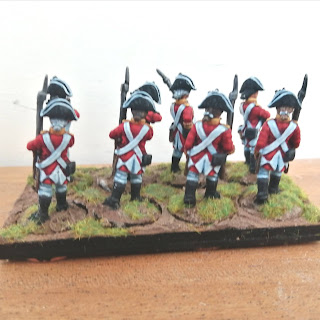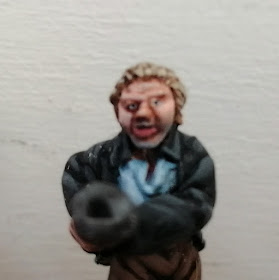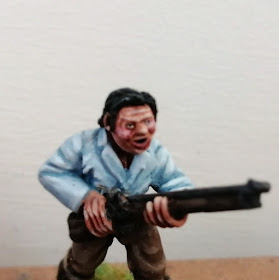I got some extra models to add variation to my British force when I was starting this project. Among these are some Londonderry Militia Grenadiers, which I've just finished up! I don't need them for the list I am working towards, but it's always good to have more options. I suppose the yellow facings they're wearing mean they could be used as North Cork Militia Grenadiers too, but I don't know much about uniforms and organisation at all!
Friday, 27 August 2021
1798 Rebellion Project Part 8: Militia Grenadiers and Yeomen
Friday, 20 August 2021
1798 Rebellion Project Part 7: The Last of the North Corks

This is the list from the Sharp Practice 1798 Supplement that I'm using for the British. I'm going to use Yeomen for the Militia under the Status II Leader, just to add some variation. All that's left to do for this list is another group of Yeos and a Status III Leader. Of course, being a wargamer, I have a few more units in the lead mountain too! I have a group of Militia Grenadiers on the desk at the moment, for example.
Saturday, 14 August 2021
1798 Rebellion Project Part 6: George of England's Hirelings
Captain Swayne and the North Cork Militia rampaged through the town of Prosperous in Co. Kildare, torturing suspected United Irishmen. During the Battle of Prosperous, the rebels set fire to the local barracks, killing the Captain and his men. Information is available here and here, but there doesn't seem to be a lot written about Swayne.
Monday, 9 August 2021
1798 Rebellion Project Part 5: a Mixed Bag of Rebels
This week I painted up another batch of United Irishmen. I added a few conversions and extra details to make them a bit more varied. I took inspiration from a few sources.
This figure was inspired by this article. A Canadian museum owns a Bronze Age Irish sword which they claim was used at the Battle of New Ross in 1798. A new handle was fitted to the weapon, and it shows signs of having been sharpened and used relatively recently. It is indeed possible that a 2500 year old sword was used during the rebellion!
This chap is armed with a fowling piece, a long barrelled gun which was used to hunt ducks. Such weapons were often used on the Wexford Slobs, and are best known from the song "John Kelly of Killann". Some had brass barrels. I cut the original barrel down, and glued on some paperclip wire in its place.
This banner features the Gal Gréine , the Irish Sunburst flag. This flag seems to have first been used in the 18th Century, and became very popular with Irish Nationalists from the 19th Century onwards. It harkens back to the legends of the Fianna, a group of heroes who sometimes referred to themselves as "Gal Gréine" or "sunbursts". I don't have any evidence that the flag was used in the 1798 Rebellion, and doubt that it made an appearance. But I think it's an eye catching design that's worth including.
Sunday, 8 August 2021
Fr. Murphy Centre, Boolavogue
As part of my efforts to visit sites relating to the rebellion of 1798, I recently visited the Fr. Murphy Centre in Boolavogue. I've previously written about Fr. Murphy and his role as a leader in my Sharp Practice force. The centre consists of several 18th and 19th century farm buildings, one of which housed Fr. Murphy from his appointment as priest in 1785 until the rebellion. At this time, Catholic priests usually didn't have parish houses, instead often staying with others. Murphy lodged with the Donoghue family.
Fr. Murphy regularly visited his friend Tom Donovan, who was a member of the United Irishmen. It may have been here that Murphy's politics began to be formed, although he would continue to follow official church doctrine and did not openly support the Society. However, Murphy began to organise resistance to British rule after numerous attacks by the Camolin Cavalry. These were spurred on by Cavalry man John Donovan, who, despite being Tom's first cousin, was possessed of very different political convictions.
Murphy encouraged his parishioners to surrender their arms to the Cavalry in exchange for guarantees of protection. However, the repression continued. This culminated in violence at The Harrow, the first rebel victory in Wexford. A group of Camolin Cavalry, including Lieutenant Bookey and John Donovan, were attacked by local men, led by Murphy. John Donovan was fatally shot by his cousin, and the yeomen were utterly defeated. Murphy’s role as a rebel leader had begun.
Fr. Murphy's room. The wooden covering was used to protect the sleeper from insects falling from the thatch!
Monday, 2 August 2021
Evoy's Forge: A 1798 Pike Factory
As part of my current project, I've made it my goal to visit some of the sites associated with the 1798 Rebellion. As I pass by many of these places on an almost daily basis, it's easy to take them for granted. I realised that it's been years since I visited these locations, so I still have lots to learn from them.
Here are some photos from a recent trip to Evoy's Forge. It's at the foot of Carrickbyrne Hill, where the United Irishmen camped before the Battle of New Ross. It is located on lands that were part of the Brown-Clayton Estate. The estate includes the Brown-Clayton Column, constructed in 1836 in honour of Ralph Abercromby, who, among other things, was briefly leader of British forces in Ireland during the rebellion.
The forge was used to produce pike heads, which were then attached to ash staves. A variety of pike designs and sizes existed, based on regional and personal preferences. They could be between 8 and 14 feet in length (See F. Thompson, "The Uniforms of 1798-1803". A valuable resource).
 The forge was restored in 1998 for the bicentenary of the rebellion. The Irish reads "This forge was restored in honour of all the smiths of 1798".
The forge was restored in 1998 for the bicentenary of the rebellion. The Irish reads "This forge was restored in honour of all the smiths of 1798". 












































